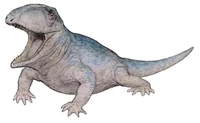Ophiacodontidae (or Ophiacodonts) were eupelycosaur synapsids. They appeared in the late Carboniferous period. Archaeothyris, and Clepsydrops were among the earliest Ophiacodontids. Archaeothyris and its relatives were the members of this family. Some ophiacodonts were semi-aquatic, and few were fully aquatic, but some were fully terrestrial like Archaeothyris. They resembled lizards in shape. They have strange, elongated skulls, they also have massive shoulder girdles, probably to provide muscle attachment to support the weight of the huge head. This family is the most primitive among synapsids and may have been ancestral to all pelycosaurs - which includes therapsids and their descendants, the mammals. By the Middle Permian, the ophiacodontids were becoming rare, and they were eventually replaced by anomodonts, the diapsid reptiles, and the evolving theriodonts, and later in the Middle Permian, the Ophiacodontids became extinct. The ophiacodonts seem to be ancestral to the therapsids, which gave rise to mammals.
Genus[]
Clepsydrops[]
Clepsydrops was a primitive ophiacodont from the early Late Carboniferous that was related to Archaeothyris and the synapsids—the ancestors of mammals. Like many other terrestrial early amniotes, it had the diet of insects and smaller animals. It also laid eggs on land rather than in the water, as most of its ancestors did. Its jaws were slightly more advanced than Paleothyris, and Hylonomus.
Protoclepsydrops[]
Protoclepsydrops was an early ophiacodont, and its skeletal remains indicate that it may have been more closely related to synapsids than to sauropsids, making it a possible synapsid member. If so, it is the oldest synapsid known, though its status is unconfirmed because its remains were fragmentary. Protoclepsydrops lived slightly earlier than Archaeothyris. Like Archaeothyris, Protoclepsydrops resembled modern lizards. However, Protoclepsydrops still had primitive vertebrae with tiny neural processes typical of the first (stem-) amniotes.
Archaeothyris[]
Archaeothyris florensis.
Archaeothyris florensis was a very early eupelycosaur synapsid, which lived in the late Carboniferous period. Dated to 306 million years ago, it is the oldest undisputed synapsid known. (Protoclepsydrops is slightly older, but its status as a synapsid is unclear as the remains are more fragmentary). It was found in Nova Scotia, at the same locality as Hylonomus lyelli, and Petrolacosaurus kansensis, all of which resemble Archaeothyris florensis.
Appearance and lifestyle[]
Unlike Hylonomus lyelli and its kin, Archaeothyris florensis was relatively large, measuring 50 centimetres (20 in) head to tail. It was also more advanced than the early sauropsids, having strong jaws that could open wider than those of the early reptiles. While its sharp teeth were all of the same shape, it did possess a pair of enlarged canines, suggesting that it was a carnivore. Archaeothyris florensis lived in what is now Nova Scotia, about 306 million years ago in the Carboniferous Period (Pennsylvanian).Nova Scotia at this time was a swamp, similar to today's Everglades in Florida. The "trees" (actually giant club mosses) were very tall, some, such as Lepidodendron, up to 50 metres (164 ft) tall. Archaeothyris florensis and the other early amniotes dwelled on the forest ground.
Ophiacodon[]
Ophiacodon (meaning "snake tooth", assigned to Ophiacodontidae by Marsh, 1878) was a large eupelycosaur. Its fossils were found in Joggins, Nova Scotia, Canada. Ophiacodon was at least two meters in length, and the largest species were up to 3.6 metres (12 ft). It is estimated to have weighed from 30 to 50 kilograms (66 to 110 lb). The size of the various species increased during the Early Permian epoch until its extinction. The skull was deep, with long jaws, and provided with sharp teeth. Ophiacodon may have eaten fishes in streams and ponds, although the high narrow skull would seem to argue against such a lifestyle. Ophiacodon is related to other animals in the family Ophiacodontidae, such as Archaeothyris. Ophiacodon was featured in the Paleoworld episode titled "Tail Of A Sail".






